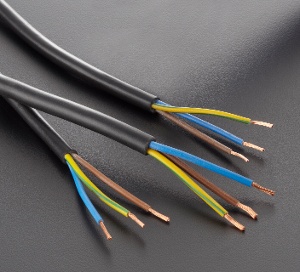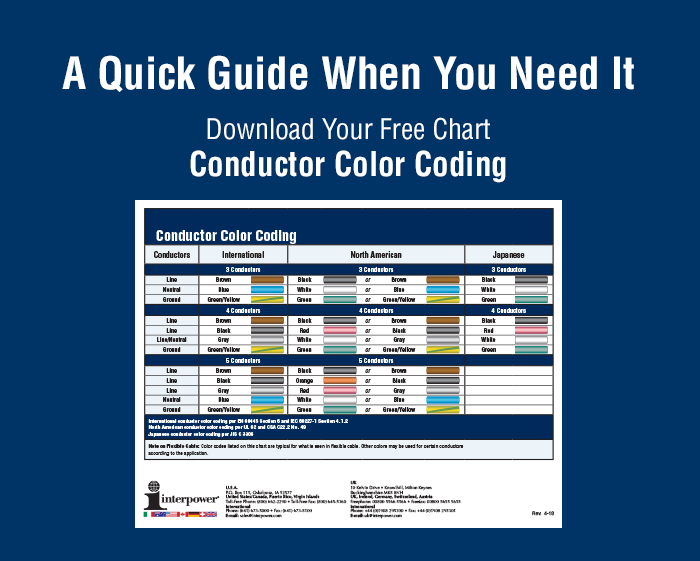 The markets where cables will be used, such as North America, Europe, Asia, or South America, will determine the type of cable and what approvals are needed—if the product is to be sold in the United States, then North American approved cable needs to be used. If it is sold in Germany, then it will need to be international approved cable. If the country is China, the cable will need a Chinese approval. Always check the standards of each country.
The markets where cables will be used, such as North America, Europe, Asia, or South America, will determine the type of cable and what approvals are needed—if the product is to be sold in the United States, then North American approved cable needs to be used. If it is sold in Germany, then it will need to be international approved cable. If the country is China, the cable will need a Chinese approval. Always check the standards of each country.
There are two main factors in considering the “correct” type of cable: how the cable will be used and the environment it will be used in. The application will determine the outer jacket material recommended for the cable: a household appliance for indoor use may have a different type of jacket than that of a power tool meant for outdoor use. Possible Materials for cable Include:
- Thermoplastic:
Thermoplastic can be softened through heating and hardened through cooling. It can be molded when heated and can retain its shape after it cools. Thermoplastic is the opposite of thermoset.
- Thermoset:
Thermoset uses a heating process called curing. Once the plastic is cured, it cannot be changed but keeps its shape.
- PVC:
PVC is a common thermoplastic material for cable and conductor jackets and some molded plugs.
- Rubber:
Rubber is also a common material for cable. It is a thermoset-type material. While it may be more costly than thermoplastic cable, it tends to be more durable with high levels of water and abrasion resistance. Rubber is a great choice for outdoor applications.
Thermoplastic Elastomer or TPE is a material that has characteristics of rubber, as well as thermoplastic. For indoor use, jacket material typically is PVC. For outdoor and/or industrial use, the jacket material may be rubber, TPE, or PVC. For outdoor use, it’s also important to determine what specific conditions the cable needs to be protected from, such as abrasion, water, oil, and sunlight.
What are the Mains Power Requirements?
Different regions and countries have different amperage and voltage requirements. These factors will affect the size and type of the cable needed to supply safe electrical power.
In North America, circuit voltage is usually 120V or 240V, using 15A for nonindustrial needs. For industrial needs, typical requirements would be 120V, 120/208V or 120/240V using 20A or less. In the European market, nonindustrial needs are usually 230V using 16A or less, whereas the industrial needs could be 230 or 400V using 32A or less.
North American and international cable standards dictate the ratings for different designated sizes. Because of the difference in ratings guidelines between the different standards, North American cable ratings do not necessarily match up with international cable rating standards.
Cable Temperatures
Typical indoor room temperatures may range from 20°C to 30°C (68°F to 86°F). Properly operating equipment may generate an additional 30°C (86°F), so cable for indoor applications is typically rated for at least 60°C (140°F). If the product is a heating appliance, consider using a rubber jacketed cable or a special heater-type cable. Outdoor or industrial ambient temperatures and equipment usually have higher extremes and therefore the cable may need to be rated from -50°C up to 105°C (-58°F up to 221°F).
UL Classification of Cable Types
| SVT |
Thermoplastic insulated vacuum cleaner cord, with or without third conductor for grounding purposes; 300V (PVC). |
| SJT |
Junior hard service, thermoplastic insulated conductors and jacket; 300V. (Typically PVC) |
| SJTW |
Same as SJT but weather-resistant for outdoor use. |
| SJTO |
Same as SJT, but oil-resistant thermoplastic outer jacket. |
| SJTOW |
Same as SJTO except weather-resistant rated. |
| ST |
Hard service cord with all thermoplastic construction, 600V. (PVC) |
| STW |
Same as ST except weather-resistant rated. (PVC) |
| STO |
Same as ST, but with oil-resistant thermoplastic outer jacket, 600V. |
| STOW |
Same as STO, but with weather-resistance. |
| SPT-1 |
Parallel jacketed thermoplastic cable, 300V. With or without third conductor for grounding. (PVC) |
| SPT-2 |
Same as SPT-1 but heavier construction. (PVC) |
| SPT-3 |
Same as SPT-2 but heavier construction. (PVC) |
| SJE |
Hard service cord, thermoplastic elastomer insulated and jacketed, 300V. (TPE) |
| SJEW |
Same as SJE except weather-resistant rated. (TPE) |
| SJEO |
Same as SJE but with oil-resistant jacket. (TPE) |
| SJEOW |
Same as SJE except weather-resistant rated. (TPE) |
| SJEOO |
Same as SJE but conductor insulation and jacket both oil-resistant. (TPE) |
| SJEOOW |
Same as SJEOO except weather-resistant rated. (TPE) |
| SE |
Extra-hard service cord, thermoplastic elastomer conductor insulation and
jacket, 600V. (TPE) |
| SEW |
Same as SE except weather-resistant rated. (TPE) |
| SEO |
Same as SE but with oil-resistant jacket. (TPE) |
| SEOW |
Same as SEO except weather-resistant rated. (TPE) |
| SEOO |
Same as SE but with oil-resistant conductor insulation and jacket. (TPE) |
| SEOOW |
Same as SEOO except weather-resistant rated. (TPE) |
| S |
Extra-hard service cord, thermoset insulated conductors and thermoset jacket, 600V. (Thermoset) |
| SO |
Same as S but with oil-resistant jacket. (Thermoset) |
| SOW |
Same as SO except weather-resistant rated. (Thermoset) |
| SOO |
Same as SO but both conductor insulation and jacket are oil-resistant. (Thermoset) |
| SOOW |
Same as SOO except weather-resistant rated. (Thermoset) |
| SJ |
Hard service cord, thermoset insulated conductors and thermoset jacket, 300V. (Thermoset) |
| SJO |
Same as SJ but with oil-resistant jacket. (Thermoset) |
| SJOW |
Same as SJO except weather-resistant rated. (Thermoset) |
| SJOO |
Same as SJO but both conductor insulation and jacket are oil-resistant. (Thermoset) |
| SJOOW |
Same as SJOO except weather-resistant rated. (Thermoset) |
When only one “O” appears in a classification (e.g., SJEOW), only the outer jacket materials is oil resistant. If there is a second “O” in the classification (e.g., SEOOW), the insulation covering the conductors and the outer jacket insulation are all oil resistant.
Definitions of cable designations are derived from UL’s designation scheme as defined in the National Electric Code (NEC) – NFPA-70.
